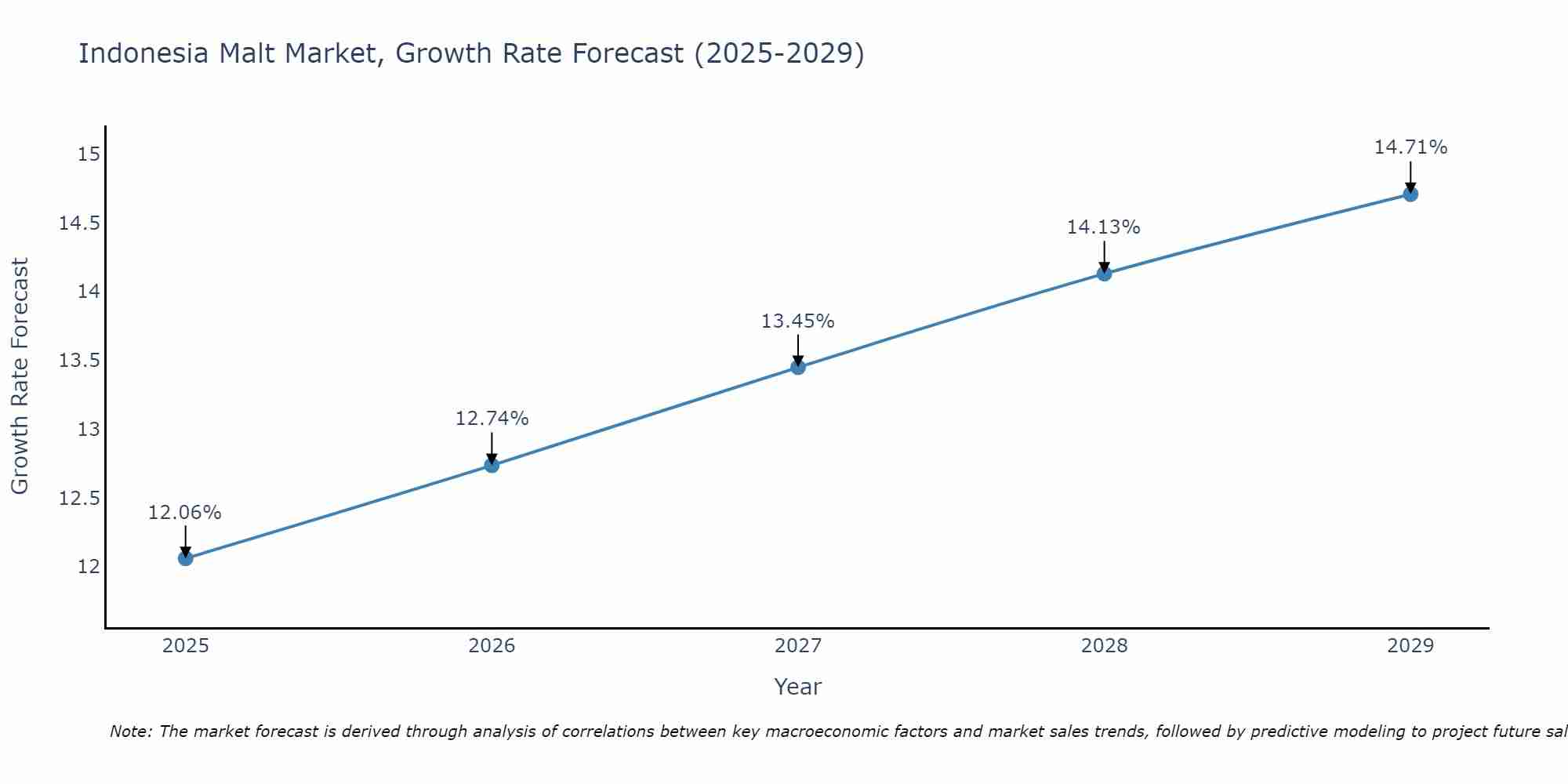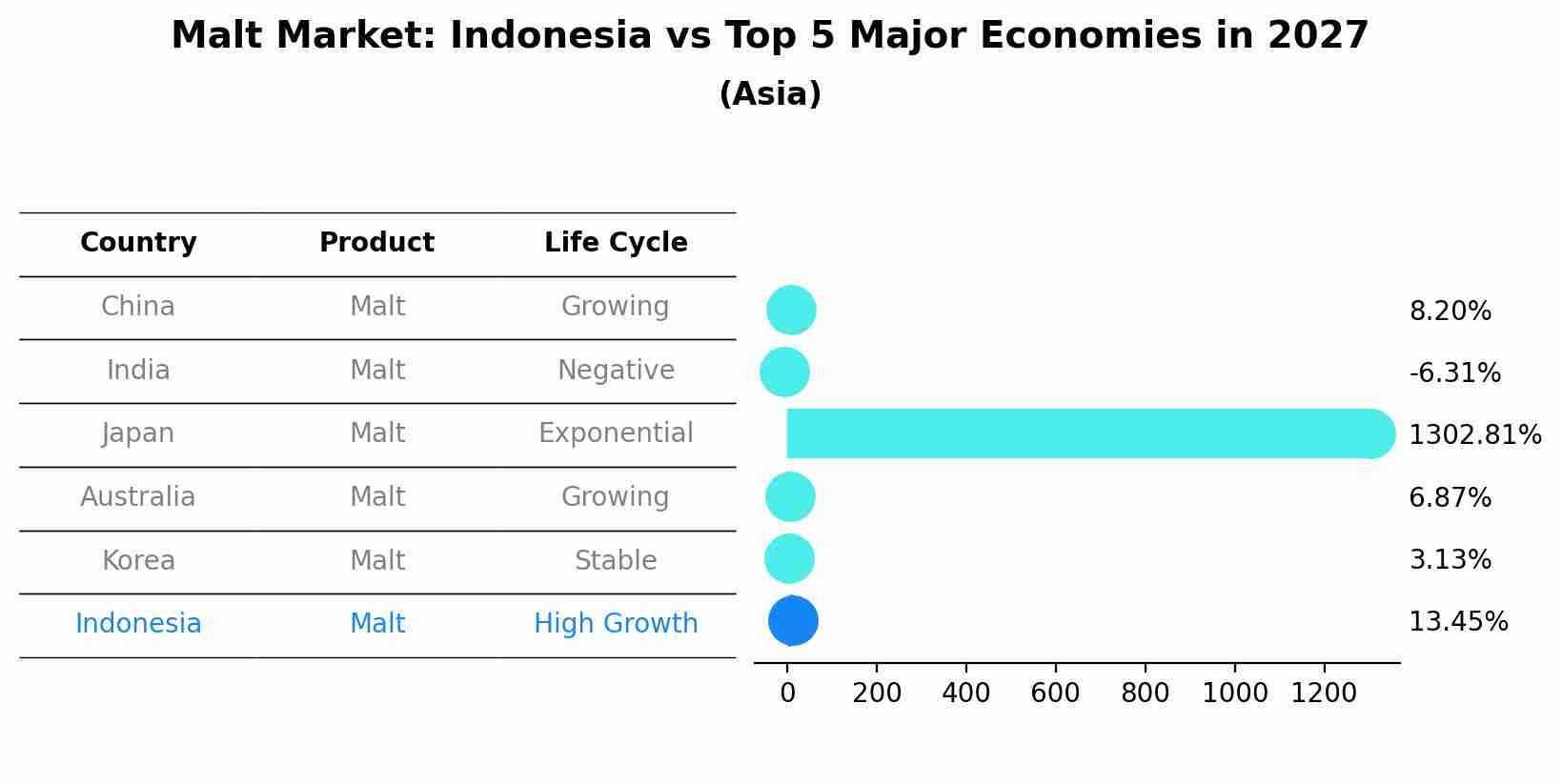Indonesia Malt Market | Size, Forecast, Trends, Value, Growth, Share, Industry, COVID-19 IMPACT, Revenue, Companies & Analysis
| Product Code: ETC179087 | Publication Date: Jul 2023 | Updated Date: Apr 2025 | Product Type: Market Research Report | |
| Publisher: 6Wresearch | No. of Pages: 70 | No. of Figures: 35 | No. of Tables: 5 | |
Indonesia Malt Market Size Growth Rate
The Indonesia Malt Market is likely to experience consistent growth rate gains over the period 2025 to 2029. From 12.06% in 2025, the growth rate steadily ascends to 14.71% in 2029.

Malt Market: Indonesia vs Top 5 Major Economies in 2027 (Asia)
Indonesia's Malt market is anticipated to experience a high growth rate of 13.45% by 2027, reflecting trends observed in the largest economy China, followed by India, Japan, Australia and South Korea.

Indonesia Malt Market Synopsis
The Indonesia malt market is one of the most vibrant markets in Southeast Asia, with a strong demand for both malted and unmalted grains. The rising consumption of beer and non-alcoholic beverages has been driving the growth of this market in recent years. Indonesia is also home to some of the world?s leading malt producers such as PT Multi Boga Raya Tbk, PT Permata Farma Inti Utama, PT Cahaya Abadi Jaya, and many others.
Market Trends
One major trend that is currently taking shape in the Indonesia Malt Market is an increased focus on sustainability practices by local players. This includes initiatives like reducing water usage during production processes or using alternative sources of energy to reduce emissions. Additionally, companies are looking into ways to increase their efficiency through automation so that they can remain competitive amidst increasing competition from abroad. Furthermore, there has been an increasing shift towards organic products in recent years due to growing health consciousness among consumers which has driven up demand for organic malts within Indonesia domestic market as well as internationally.
Market Drivers
Some key drivers for growth within the Indonesia Malt Market include a rise in consumer spending power along with a sustained economic growth rate over recent years coupled with government policies aimed at boosting production capacity and encouraging foreign investment into agriculture businesses-related enterprises have further helped fuel its expansion. Furthermore, technological advancements such as automated systems being implemented by various manufacturers have enabled them to produce high quality products at competitive prices while maintaining cost efficiencies ? all these factors are expected to sustain industry momentum going forward.
COVID-19 Impact on the Market
The novel coronavirus outbreak has had a severe impact on global economies across different sectors including food & beverage industry which heavily relies on exports - especially those related to supplies used in producing beers and non-alcoholic drinks where malt plays an important role amongst other ingredients required for making beverages such as hops etc.. Due to disruptions caused by restrictions imposed due limitations posed by COVID-19 pandemic , it resulted into shortages / inadequate availability resulting into price hikes due reduced supply channels available , impacting overall profitability margins derived out from malt sales.
Challenges of the Market
The industry faces several challenges related to rising raw material costs, low access to credit facilities, lack of innovation and technology investments by firms in order to compete with international producers. Additionally, there is inadequate infrastructure which impacts transportation costs leading to price hikes for milled grain products like wheat flour and barley seed meal used in malting process. Lastly, high levels of taxation have also impacted profitability negatively among suppliers of malt ingredients such as hops and yeast extract powder used for brewing purposes which could affect end product quality if not managed properly.
Industry Key Players
Some key players operating within the Indonesia Malt Market include PT Multi Bintang Indonesia Tbk., PT Indofood Sukses Makmur Tbk., PT Sarimelati Kencana Tbk., PT Gudang Garam Tbk., Pabrik Teh KotabaruIndo Ltd Co., Heineken Nederland BV among others who offer various types of malts such as powdered malt extract (PME), dried brewers? grains (DBG) etc.
Key Highlights of the Report:
- Indonesia Malt Market Outlook
- Market Size of Indonesia Malt Market, 2023
- Forecast of Indonesia Malt Market, 2030
- Historical Data and Forecast of Indonesia Malt Revenues & Volume for the Period 2020-2030
- Indonesia Malt Market Trend Evolution
- Indonesia Malt Market Drivers and Challenges
- Indonesia Malt Price Trends
- Indonesia Malt Porter's Five Forces
- Indonesia Malt Industry Life Cycle
- Historical Data and Forecast of Indonesia Malt Market Revenues & Volume By Type for the Period 2020-2030
- Historical Data and Forecast of Indonesia Malt Market Revenues & Volume By Malt for the Period 2020-2030
- Historical Data and Forecast of Indonesia Malt Market Revenues & Volume By Malt Extract for the Period 2020-2030
- Historical Data and Forecast of Indonesia Malt Market Revenues & Volume By Malt Extract Powder for the Period 2020-2030
- Historical Data and Forecast of Indonesia Malt Market Revenues & Volume By Malt Flour for the Period 2020-2030
- Historical Data and Forecast of Indonesia Malt Market Revenues & Volume By Barley malt for the Period 2020-2030
- Historical Data and Forecast of Indonesia Malt Market Revenues & Volume By Wheat malt for the Period 2020-2030
- Historical Data and Forecast of Indonesia Malt Market Revenues & Volume By Rye malt for the Period 2020-2030
- Historical Data and Forecast of Indonesia Malt Market Revenues & Volume By Application for the Period 2020-2030
- Historical Data and Forecast of Indonesia Malt Market Revenues & Volume By Beer Industry for the Period 2020-2030
- Historical Data and Forecast of Indonesia Malt Market Revenues & Volume By Whisky Distilleries for the Period 2020-2030
- Historical Data and Forecast of Indonesia Malt Market Revenues & Volume By Food industry for the Period 2020-2030
- Historical Data and Forecast of Indonesia Malt Market Revenues & Volume By Beverages for the Period 2020-2030
- Historical Data and Forecast of Indonesia Malt Market Revenues & Volume By Pharmaceutical industry for the Period 2020-2030
- Indonesia Malt Import Export Trade Statistics
- Market Opportunity Assessment By Type
- Market Opportunity Assessment By Application
- Indonesia Malt Top Companies Market Share
- Indonesia Malt Competitive Benchmarking By Technical and Operational Parameters
- Indonesia Malt Company Profiles
- Indonesia Malt Key Strategic Recommendations
Frequently Asked Questions About the Market Study (FAQs):
1 Executive Summary |
2 Introduction |
2.1 Key Highlights of the Report |
2.2 Report Description |
2.3 Market Scope & Segmentation |
2.4 Research Methodology |
2.5 Assumptions |
3 Indonesia Malt Market Overview |
3.1 Indonesia Country Macro Economic Indicators |
3.2 Indonesia Malt Market Revenues & Volume, 2020 & 2030F |
3.3 Indonesia Malt Market - Industry Life Cycle |
3.4 Indonesia Malt Market - Porter's Five Forces |
3.5 Indonesia Malt Market Revenues & Volume Share, By Type, 2020 & 2030F |
3.6 Indonesia Malt Market Revenues & Volume Share, By Application, 2020 & 2030F |
4 Indonesia Malt Market Dynamics |
4.1 Impact Analysis |
4.2 Market Drivers |
4.3 Market Restraints |
5 Indonesia Malt Market Trends |
6 Indonesia Malt Market, By Types |
6.1 Indonesia Malt Market, By Type |
6.1.1 Overview and Analysis |
6.1.2 Indonesia Malt Market Revenues & Volume, By Type, 2020-2030F |
6.1.3 Indonesia Malt Market Revenues & Volume, By Malt, 2020-2030F |
6.1.4 Indonesia Malt Market Revenues & Volume, By Malt Extract, 2020-2030F |
6.1.5 Indonesia Malt Market Revenues & Volume, By Malt Extract Powder, 2020-2030F |
6.1.6 Indonesia Malt Market Revenues & Volume, By Malt Flour, 2020-2030F |
6.1.7 Indonesia Malt Market Revenues & Volume, By Barley malt, 2020-2030F |
6.1.8 Indonesia Malt Market Revenues & Volume, By Wheat malt, 2020-2030F |
6.2 Indonesia Malt Market, By Application |
6.2.1 Overview and Analysis |
6.2.2 Indonesia Malt Market Revenues & Volume, By Beer Industry , 2020-2030F |
6.2.3 Indonesia Malt Market Revenues & Volume, By Whisky Distilleries, 2020-2030F |
6.2.4 Indonesia Malt Market Revenues & Volume, By Food industry , 2020-2030F |
6.2.5 Indonesia Malt Market Revenues & Volume, By Beverages , 2020-2030F |
6.2.6 Indonesia Malt Market Revenues & Volume, By Pharmaceutical industry, 2020-2030F |
7 Indonesia Malt Market Import-Export Trade Statistics |
7.1 Indonesia Malt Market Export to Major Countries |
7.2 Indonesia Malt Market Imports from Major Countries |
8 Indonesia Malt Market Key Performance Indicators |
9 Indonesia Malt Market - Opportunity Assessment |
9.1 Indonesia Malt Market Opportunity Assessment, By Type, 2020 & 2030F |
9.2 Indonesia Malt Market Opportunity Assessment, By Application, 2020 & 2030F |
10 Indonesia Malt Market - Competitive Landscape |
10.1 Indonesia Malt Market Revenue Share, By Companies, 2023 |
10.2 Indonesia Malt Market Competitive Benchmarking, By Operating and Technical Parameters |
11 Company Profiles |
12 Recommendations |
13 Disclaimer |
- Single User License$ 1,995
- Department License$ 2,400
- Site License$ 3,120
- Global License$ 3,795
Search
Related Reports
- Portugal Electronic Document Management Market (2025-2031) | Strategy, Consumer Insights, Analysis, Investment Trends, Opportunities, Growth, Size, Share, Industry, Revenue, Segments, Value, Segmentation, Supply, Forecast, Restraints, Outlook, Competition, Drivers, Trends, Demand, Pricing Analysis, Competitive, Strategic Insights, Companies, Challenges
- France Electronic Document Management Market (2025-2031) | Strategy, Consumer Insights, Analysis, Investment Trends, Opportunities, Growth, Size, Share, Industry, Revenue, Segments, Value, Segmentation, Supply, Forecast, Restraints, Outlook, Competition, Drivers, Trends, Demand, Pricing Analysis, Competitive, Strategic Insights, Companies, Challenges
- Portugal Occupational Health & Safety Services Market (2025-2031) | Strategy, Consumer Insights, Analysis, Investment Trends, Opportunities, Growth, Size, Share, Industry, Revenue, Segments, Value, Segmentation, Supply, Forecast, Restraints, Outlook, Competition, Drivers, Trends, Demand, Pricing Analysis, Competitive, Strategic Insights, Companies, Challenges
- Netherlands Occupational Health and Safety Services Market (2025-2031) | Strategy, Consumer Insights, Analysis, Investment Trends, Opportunities, Growth, Size, Share, Industry, Revenue, Segments, Value, Segmentation, Supply, Forecast, Restraints, Outlook, Competition, Drivers, Trends, Demand, Pricing Analysis, Competitive, Strategic Insights, Companies, Challenges
- Belgium and Luxembourg Facility Management Market (2025-2031) | Strategy, Consumer Insights, Analysis, Investment Trends, Opportunities, Growth, Size, Share, Industry, Revenue, Segments, Value, Segmentation, Supply, Forecast, Restraints, Outlook, Competition, Drivers, Trends, Demand, Pricing Analysis, Competitive, Strategic Insights, Companies, Challenges
- Russia Women Intimate Apparel Market (2025-2031) | Strategy, Consumer Insights, Analysis, Investment Trends, Opportunities, Growth, Size, Share, Industry, Revenue, Segments, Value, Segmentation, Supply, Forecast, Restraints, Outlook, Competition, Drivers, Trends, Demand, Pricing Analysis, Competitive, Strategic Insights, Companies, Challenges
- Africa Chocolate Market (2025-2031) | Size, Share, Trends, Growth, Revenue, Analysis, Forecast, industry & Outlook
- Global Hydroxychloroquine And Chloroquine Market (2025-2031) | Industry, Trends, Size, Outlook, Growth, Value, Companies, Revenue, Analysis, Share, Forecast
- Saudi Arabia Plant Maintenance Market (2025-2031) | Industry, Size, Growth, Revenue, Value, Companies, Forecast, Analysis, Share & Trends
- Taiwan Electric Truck Market (2025-2031) | Outlook, Industry, Revenue, Size, Forecast, Growth, Analysis, Share, Companies, Value & Trends
Industry Events and Analyst Meet
Our Clients
Whitepaper
- Middle East & Africa Commercial Security Market Click here to view more.
- Middle East & Africa Fire Safety Systems & Equipment Market Click here to view more.
- GCC Drone Market Click here to view more.
- Middle East Lighting Fixture Market Click here to view more.
- GCC Physical & Perimeter Security Market Click here to view more.
6WResearch In News
- Doha a strategic location for EV manufacturing hub: IPA Qatar
- Demand for luxury TVs surging in the GCC, says Samsung
- Empowering Growth: The Thriving Journey of Bangladesh’s Cable Industry
- Demand for luxury TVs surging in the GCC, says Samsung
- Video call with a traditional healer? Once unthinkable, it’s now common in South Africa
- Intelligent Buildings To Smooth GCC’s Path To Net Zero













